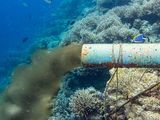Marine Pollution
Fact About Ocean Pollution: For upon |ocean pollution marine pollution is a combination of chemicals and trash, most of which comes from land sources and is washed or blown into the ocean. This pollution results in damage to the environment, the health of all organisms, and economic structures worldwide.
Water Pollution
Pollutants are dumped into the ocean. This waste affects the daily life of fish and other marine creatures.
Marine pollution is a growing problem in today’s world. Our ocean is being flooded with two main types of pollution: chemicals and trash.
Chemical contamination, or nutrient pollution, is concerning for health, environmental, and economic reasons. This type of pollution occurs when human activities, notably the use of fertilizer on farms, lead to the runoff of chemicals into waterways that ultimately flow into the ocean. The increased concentration of chemicals, such as nitrogen and phosphorus, in the coastal ocean, promotes the growth of algal blooms, which can be toxic to wildlife and harmful to humans. The negative effects on health and the environment caused by algal blooms hurt local fishing and tourism industries.
Marine trash encompasses all manufactured products—most of the plastic—that end up in the ocean. Littering, storm winds, and poor waste management all contribute to the accumulation of this debris, 80 percent of which comes from sources on land. Common types of marine debris include various plastic items like shopping bags and beverage bottles, along with cigarette butts, bottle caps, food wrappers, and fishing gear. Plastic waste is particularly problematic as a pollutant because it is so long-lasting. Plastic items can take hundreds of years to decompose.
This trash poses dangers to both humans and animals. Fish become tangled and injured in the debris, and some animals mistake items like plastic bags for food and eat them. Small organisms feed on tiny bits of broken-down plastic, called microplastic, and absorb the chemicals from the plastic into their tissues. Microplastics are less than five millimeters (0.2 inches) in diameter and have been detected in a range of marine species, including plankton and whales. When small organisms that consume microplastics are eaten by larger animals, the toxic chemicals then become part of their tissues. In this way, microplastic pollution migrates up the food chain, eventually becoming part of the food that humans eat.
Solutions for marine pollution include prevention and cleanup. Disposable and single-use plastic is abundantly used in today’s society, from shopping bags to shipping packaging to plastic bottles. Changing society’s approach to plastic use will be a long and economically challenging process. Cleanup, in contrast, may be impossible for some items. Many types of debris (including some plastics) do not float, so they are lost deep in the ocean. Plastics that do float tend to collect in large “patches” in ocean gyres.
The Pacific Garbage Patch is one example of such a collection, with plastics and microplastics floating on and below the surface of swirling ocean currents between California and Hawaii in an area of about 1.6 million square kilometers (617,763 square miles), although its size is not fixed. These patches are less like islands of trash and, as the National Oceanic and Atmospheric Administration says, more like flecks of microplastic pepper swirling around an ocean soup. Even some promising solutions are inadequate for combating marine pollution. So-called “biodegradable” plastics often break down only at temperatures higher than will ever be reached in the ocean.
Nonetheless, many countries are taking action. According to a 2018 report from the United Nations, more than sixty countries have enacted regulations to limit or ban the use of disposable plastic items. Fact About Ocean Pollution.

Pollutants are dumped into the ocean. This waste affects the daily life of fish and other marine creatures.
stock photo-graf/Shutterstock
The article was originally published here.


Comments are closed.